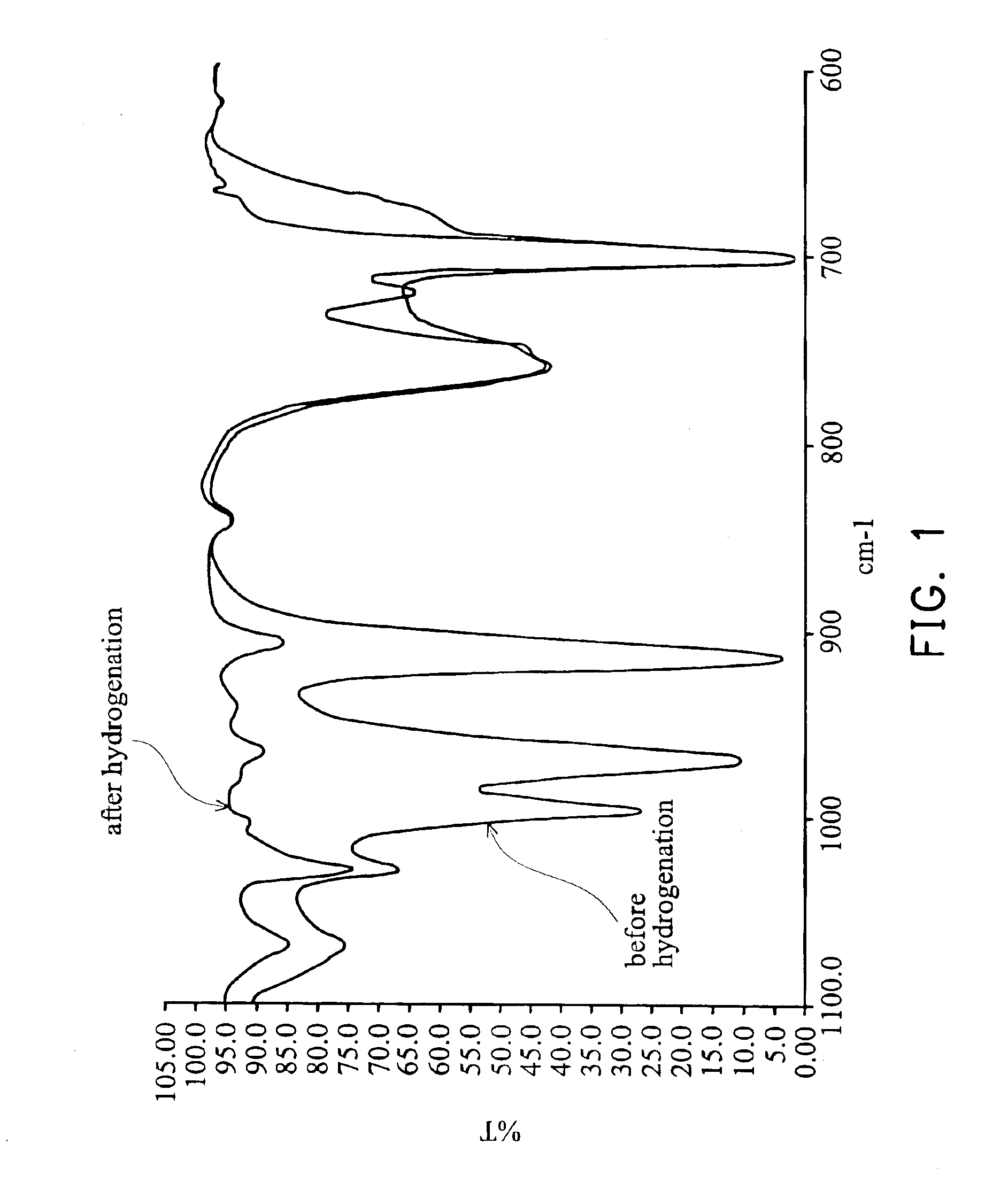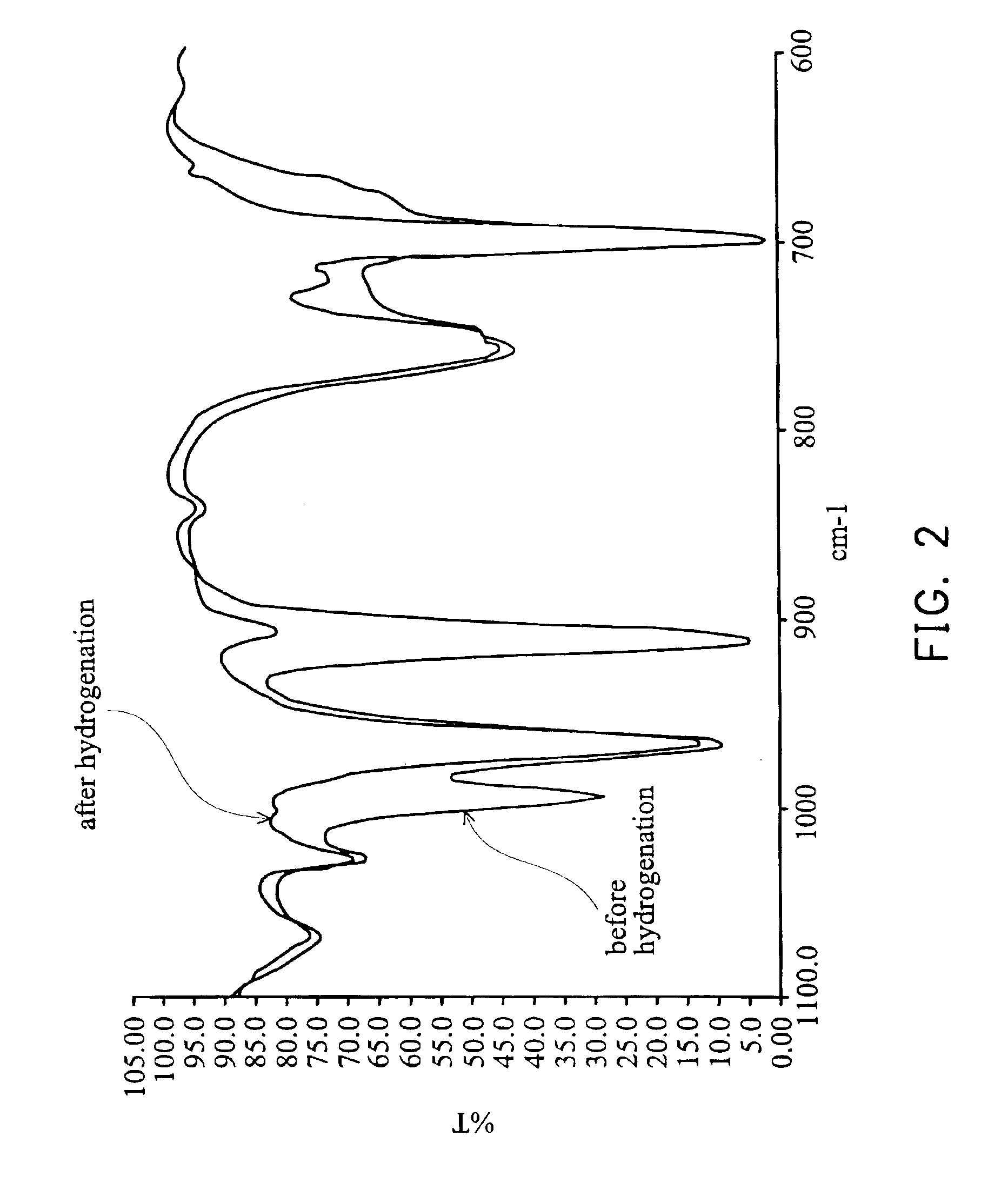Process for hydrogenation of conjugated diene polymer
a technology of conjugated dienes and polymers, applied in the field of conjugated diene polymer hydrogenation, can solve the problems of oxidation and ozone, lack of stability to resist weather conditions, and even more severe disadvantages of conjugated dienes and vinyl aromatic hydrocarbons, and achieve the effects of enhancing economic efficiency, high activity, and enhancing efficiency
- Summary
- Abstract
- Description
- Claims
- Application Information
AI Technical Summary
Benefits of technology
Problems solved by technology
Method used
Image
Examples
example 1
Preparation of SBS Copolymer
[0079]5400 g of cyclohexane, 7.4 mmole of n-butyl lithium, and 252 mmole of tetrahydrofuran (THF) were charged in 10 L of a heater equipped with a stirrer. Then, 96 g of styrene was added and the polymerization was conducted at 45° C. Then, 400 g of 1,3-butadiene and 96 g of styrene were added to the reaction system and the reaction mixture was further polymerized to an SBS (styrene-butadiene-styrene) tri-block copolymer (solid content=9.7%, Mw=230,000).
example 2
[0080]1000 g of the polymer solution of SBS tri-block copolymer prepared from Example 1 was transferred to a pressure-resistant hydrogenation vessel and maintained in nitrogen atmosphere. 0.11 mmole of titanium(IV) isopropoxide was dissolved in 10 ml of cyclohexane at room temperature, 0.11 mmole of titanium(IV) isopropoxide and 0.16 mmole of n-butyl lithium were mixed in 10 ml of cyclohexane in a glove box, and 0.055 mmole of bis(cyclopentadienyl)titanium dichloride and 0.33 mmole of triisobutyl aluminum were mixed in 20 ml of cyclohexane. The above solutions were added to the SBS copolymer. Hydrogen was fed in under a pressure of 25 kg / cm2 to undergo hydrogenation at 80° C.
[0081]FIG. 1 shows IR spectra of the SBS copolymer before and after hydrogenation. It can be seen that in the spectrum of the SBS tri-block copolymer before hydrogenation, the trans double bond is present at the wavelength peaks 968 cm−1 and 995 cm−1 and the 1,2-vinyl group double bond is present at the waveleng...
example 3
[0082]1000 g of the polymer solution of SBS tri-block copolymer prepared from Example 1 was transferred to a pressure-resistant hydrogenation vessel and maintained in nitrogen atmosphere. 0.11 mmole of titanium(IV) isopropoxide was dissolved in 10 ml of cyclohexane at room temperature, 0.055 mmole of bis(cyclopentadienyl)titanium dichloride was dissolved in 10 ml of cyclohexane, and 0.33 mmole of triisobutyl aluminum was dissolved in 10 ml of cyclohexane. The above solutions were added to the SBS copolymer. Hydrogen was fed in under a pressure of 25 kg / cm2 to undergo hydrogenation at 80° C. The 1,3-butadiene hydrogenation conversion was measured to reach 76% after 30 minutes and reach 97% after 1 hour. The hydrogenation data are summarized in Table 1.
PUM
| Property | Measurement | Unit |
|---|---|---|
| temperature | aaaaa | aaaaa |
| molar ratio | aaaaa | aaaaa |
| temperature | aaaaa | aaaaa |
Abstract
Description
Claims
Application Information
 Login to View More
Login to View More - R&D
- Intellectual Property
- Life Sciences
- Materials
- Tech Scout
- Unparalleled Data Quality
- Higher Quality Content
- 60% Fewer Hallucinations
Browse by: Latest US Patents, China's latest patents, Technical Efficacy Thesaurus, Application Domain, Technology Topic, Popular Technical Reports.
© 2025 PatSnap. All rights reserved.Legal|Privacy policy|Modern Slavery Act Transparency Statement|Sitemap|About US| Contact US: help@patsnap.com



